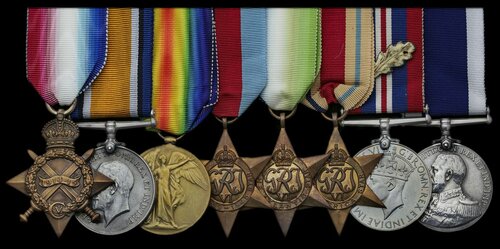
Auction: 21002 - Orders, Decorations and Medals
Lot: 197
Eight: Petty Officer E. W. Pederson, Royal Navy, a long-served Submariner who returned to the fold during the Second World War, who earned a 'mention' and was killed in action when H.M.S. Chakdina was torpedoed on 5 December 1941, aged 46
1914-15 Star (J.11564. E. W. Pederson. A.B., R.N.); British War and Victory Medals (J.11564 E. W. Pederson. L.S. R.N.); 1939-45 Star; Atlantic Star; Africa Star; War Medal 1939-45, with M.I.D. oak leaf; Royal Navy L.S. & G.C., G.V.R. (J.11564 E. W. Pederson. P.O. H.M.S. Defiance.), good very fine (8)
Ernest William Pederson was born on 7 February 1895 at Southwark and was an office boy upon his joining the Royal Navy on 15 March 1911. He served aboard Bellerophon from 2 May 1912-9 January 1915 and was aboard her when the Grand Fleet sortied during the German raid on Scarborough, Hartlepool and Whitby on 16 December 1914. Having volunteered for submarines, he joined Dolphin from 20 May-7 June 1915, then Arrogant from 8 June-30 September 1915, before joining C-17 from 1 October 1915-13 July 1917. He was transferred to the books of E-27 from 14 July-3 September 1917, before coming ashore. A second tour in E-27 lasted from 13 February-2 May 1918. Pederson remained in the submarine service long into the 1920s, earning his L.S. & G.C. Medal on 27 March 1928. He was pensioned on 6 February 1935 and demobilised on 2 October.
Upon the outbreak of the Second World War, experience hands like Pederson were called for. He served aboard the aircraft carrier Hermes from 23 August 1939-17 June 1941, earning a 'mention' in the process (London Gazette 1 January 1941, refers. As per ADM 363/154/137).
Pederson, now a Petty Officer, joined H.M.S. Chakdina on 18 June 1941. New Zealand Medical Services in Middle East and Italy takes up the fateful events on 5 December 1941:
'Two ships with two escort vessels left Tobruk for Alexandria at 5.30p.m. The larger of the two, the Chakdina, under arrangements made by ADMS Tobruk, Colonel Fulton, carried 380 wounded, including 97 New Zealanders. These wounded had been held up inside Tobruk and the decision had been made to evacuate them by sea to base hospitals in Egypt. Most of the ninety-seven wounded New Zealanders on board were stretcher cases and were put in the aft hold between decks.
Just as the moon was rising, a little after nine o'clock, the Chakdina, which was not a hospital ship, was attacked by a torpedo-carrying aircraft. Approaching at a height of barely 50 feet, the plane released a torpedo which exploded in one of the aft holds. Immediately the ship began to sink by the stern and in three and a half minutes it had disappeared.
Of those below deck—for the most part prisoners and the seriously wounded—few were able to escape. The men on deck had a better chance of fending for themselves, but many, too, were drowned, some by the upsetting of lifeboats, others by the suction of the sinking ship. For the wounded trapped in the aft hold there was small chance of escape, but there were several remarkable escapes when the exploding boilers caused an upward surge of water that thrust some to the surface. These and others were picked up by ships of the convoy which carried out rescue work for two hours despite continued air attacks.'
Pederson, who left his wife Ada, who was living at Harrow, is commemorated upon the Plymouth Naval Memorial.
Subject to 20% VAT on Buyer’s Premium. For more information please view Terms and Conditions for Buyers.
Sold for
£370
Starting price
£140




